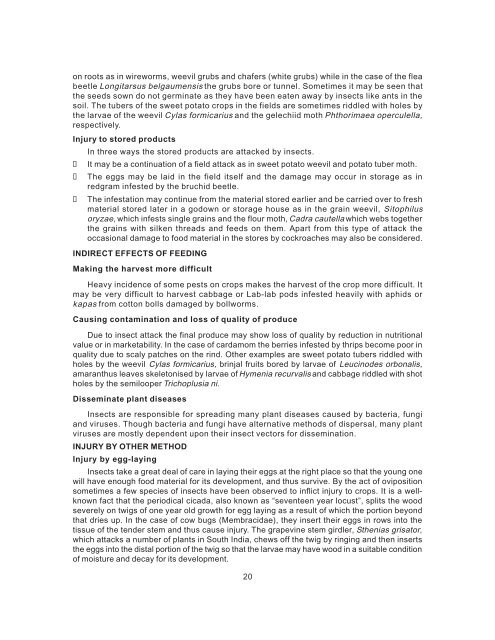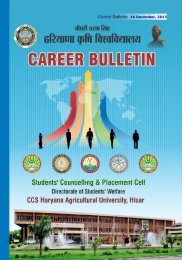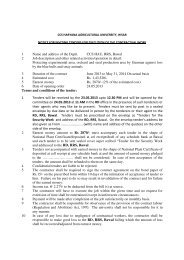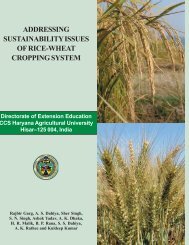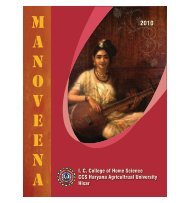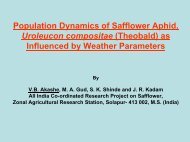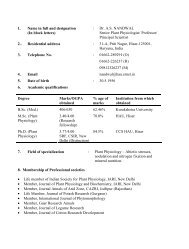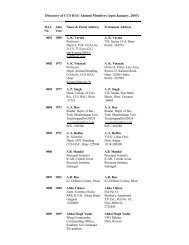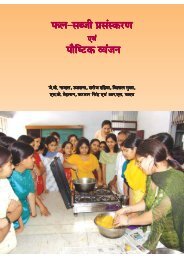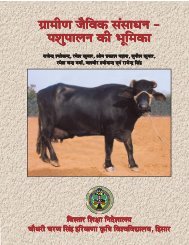Foreword - CCS HAU, Hisar
Foreword - CCS HAU, Hisar
Foreword - CCS HAU, Hisar
Create successful ePaper yourself
Turn your PDF publications into a flip-book with our unique Google optimized e-Paper software.
on roots as in wireworms, weevil grubs and chafers (white grubs) while in the case of the flea<br />
beetle Longitarsus belgaumensis the grubs bore or tunnel. Sometimes it may be seen that<br />
the seeds sown do not germinate as they have been eaten away by insects like ants in the<br />
soil. The tubers of the sweet potato crops in the fields are sometimes riddled with holes by<br />
the larvae of the weevil Cylas formicarius and the gelechiid moth Phthorimaea operculella,<br />
respectively.<br />
Injury to stored products<br />
In three ways the stored products are attacked by insects.<br />
It may be a continuation of a field attack as in sweet potato weevil and potato tuber moth.<br />
The eggs may be laid in the field itself and the damage may occur in storage as in<br />
redgram infested by the bruchid beetle.<br />
The infestation may continue from the material stored earlier and be carried over to fresh<br />
material stored later in a godown or storage house as in the grain weevil, Sitophilus<br />
oryzae, which infests single grains and the flour moth, Cadra cautella which webs together<br />
the grains with silken threads and feeds on them. Apart from this type of attack the<br />
occasional damage to food material in the stores by cockroaches may also be considered.<br />
INDIRECT EFFECTS OF FEEDING<br />
Making the harvest more difficult<br />
Heavy incidence of some pests on crops makes the harvest of the crop more difficult. It<br />
may be very difficult to harvest cabbage or Lab-lab pods infested heavily with aphids or<br />
kapas from cotton bolls damaged by bollworms.<br />
Causing contamination and loss of quality of produce<br />
Due to insect attack the final produce may show loss of quality by reduction in nutritional<br />
value or in marketability. In the case of cardamom the berries infested by thrips become poor in<br />
quality due to scaly patches on the rind. Other examples are sweet potato tubers riddled with<br />
holes by the weevil Cylas formicarius, brinjal fruits bored by larvae of Leucinodes orbonalis,<br />
amaranthus leaves skeletonised by larvae of Hymenia recurvalis and cabbage riddled with shot<br />
holes by the semilooper Trichoplusia ni.<br />
Disseminate plant diseases<br />
Insects are responsible for spreading many plant diseases caused by bacteria, fungi<br />
and viruses. Though bacteria and fungi have alternative methods of dispersal, many plant<br />
viruses are mostly dependent upon their insect vectors for dissemination.<br />
INJURY BY OTHER METHOD<br />
Injury by egg-laying<br />
Insects take a great deal of care in laying their eggs at the right place so that the young one<br />
will have enough food material for its development, and thus survive. By the act of oviposition<br />
sometimes a few species of insects have been observed to inflict injury to crops. It is a wellknown<br />
fact that the periodical cicada, also known as “seventeen year locust”, splits the wood<br />
severely on twigs of one year old growth for egg laying as a result of which the portion beyond<br />
that dries up. In the case of cow bugs (Membracidae), they insert their eggs in rows into the<br />
tissue of the tender stem and thus cause injury. The grapevine stem girdler, Sthenias grisator,<br />
which attacks a number of plants in South India, chews off the twig by ringing and then inserts<br />
the eggs into the distal portion of the twig so that the larvae may have wood in a suitable condition<br />
of moisture and decay for its development.<br />
20


